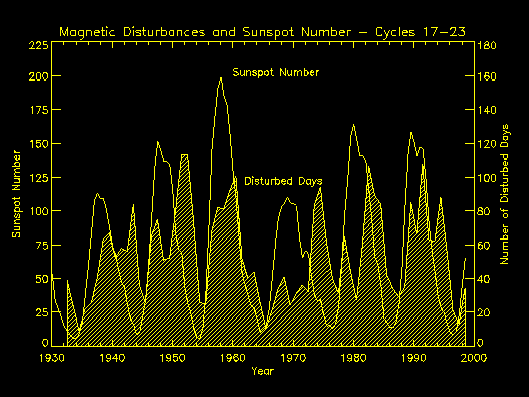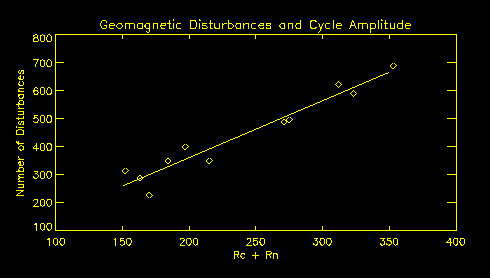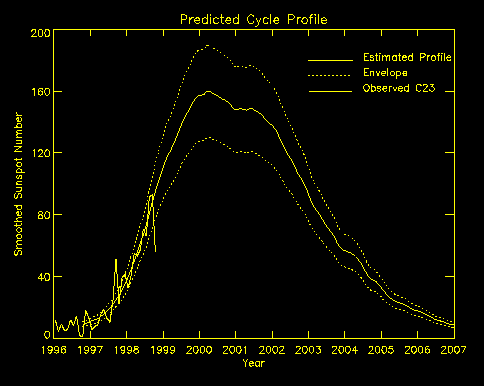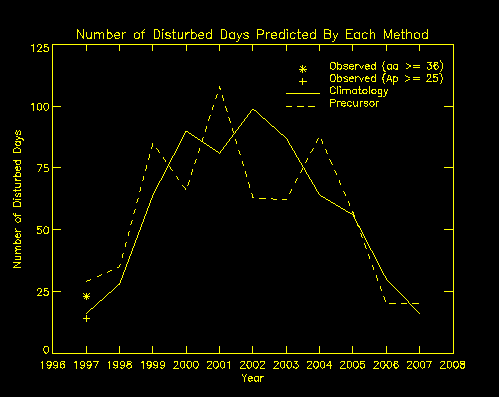| GSP Study Archive |
| Space Weather Studies |
| Applications Pilot Project |
| Feasibility Studies |
| CDF Space Weather Study |
| Past Workshops |
| Past Publications |
SOLAR AND GEOMAGNETIC ACTIVITY DURING SOLAR CYCLE 23
A.W.P. Thomson,* R.J. Thompson,** J.A. Joselyn***
| * | Global Seismology and Geomagnetism Group, British Geological Survey, West Mains Road, Edinburgh, EH9 3LA, United Kingdom |
| ** | IPS Radio and Space Services, PO Box 1386, Haymarket, NSW 1240, Australia |
| *** | Space Environment Center, 325 Broadway, Boulder, CO 80303, USA |
ABSTRACT
1. INTRODUCTION
2. A REVIEW OF PUBLISHED PREDICTIONS
3. THE CONSENSUS FORECAST
4. WHEN DID CYCLE 23 REALLY START?
5. GEOMAGNETIC ACTIVITY PREDICTION
6. SUMMARY
7. REFERENCES
ABSTRACT 
Under a contract from NASA, the US Space Environment Center organised an international panel of scientists to provide a prediction of the amplitude, timing, and profile of the new solar cycle 23 (Ref 1). This panel met in Boulder in September 1996 to formulate its prediction and then again at Sacramento Peak in 1997, and at Nantucket Island in 1998 to update its predictions. The panel predicts that Cycle 23 will reach a peak smoothed sunspot number of 160 with this peak expected to occur around April 2000. The panel also made a prediction of geomagnetic activity to be expected over Cycle 23 - a novel type of prediction which is in increasing demand.
1. INTRODUCTION 
The variation in the appearance of sunspots is one of the longest observational data sets. The records show a solar cycle of roughly 11 years in duration with an amplitude varying greatly from cycle-to-cycle. There are also longer timescale changes where there are intervals of smaller than average cycles or other intervals where cycles tend to be large.
Modern technology, and especially human space activity, has developed in a period of extremely large cycles. Cycle 19, which peaked in 1957, was the largest cycle on record reaching a smoothed sunspot number of 201. Cycle 21, peaking in 1979 at a sunspot number of 165, was the second largest on record; and the most recent completed cycle, Cycle 22, was the third largest on record (peak sunspot number of 158 in 1989).

Figure 1. Variation of the sunspot number and the number of geomagnetic disturbances since 1932.
A geomagnetic disturbance is defined as a day for which Ap >= 25.
The last low point of the solar cycle was reached in 1996. At solar minimum there is great interest in the amplitude and timing of the new solar cycle. Will Cycle 23 continue the trend of large cycles, perhaps even eclipsing Cycle 19 as the largest on record; or will the cycle revert to a lower amplitude as the historical records indicate that it must eventually?
Predictions of solar and associated geomagnetic activity are crucial for many activities including:
- Scientific Research
- Planning Spacecraft Operations
- Affects Low Altitude Satellite Drag
- Planning HF Communications
Predictions of Cycle 23 had been appearing in scientific journals for several years prior to 1996. There was a need for a definitive prediction of the cycle based on a survey of these predictions and an assessment of the underlying techniques upon which such predictions are based. As a result, under the sponsorship of NASA, the US Space Environment Center (SEC) formed an international panel of scientists to undertake this task. The composition of the panel was as follows:
Table 1. Membership of the Prediction Panel.
Name |
Organisation |
| JoAnn Joselyn (chair) | Space Environment Center |
| Jeff Anderson | NASA/Marshall Space Flight Center |
| Helen Coffey | National Geophysical Data Center |
| Karen Harvey | Solar Physics Research Corporation |
| David Hathaway | NASA/Marshall Space Flight Center |
| Gary Heckman | Space Environment Center |
| Ernie Hildner | Space Environment Center |
| Werner Mende | Free University of Berlin (Germany) |
| Ken Schatten | National Science Foundation |
| Richard Thompson | IPS Radio and Space Services (Australia) |
| Alan Thomson | British Geological Survey (Britain) |
| Dick White | National Center for Atmospheric Research |
In 1996 the panel met in Boulder to review published predictions, to survey prediction techniques, and to arrive at a consensus forecast of the amplitude and other solar parameters. At the date of this meeting the time of solar minimum was not yet known and so a further meeting was held in 1997 to revise the panel forecasts. By late 1998 two years of the new cycle had been observed and another meeting was held to
reconsider the prediction.
Table 2. Meetings of the Prediction Panel.
Date |
Location |
| September 1996 | Boulder, USA |
| September 1997 | Sacramento Peak, USA |
| October 1998 | Nantucket, USA |
2. A REVIEW OF PUBLISHED PREDICTIONS 
The panel reviewed published predictions of the amplitude of Cycle 23 and sorted them according to the technique on which the prediction was based. The techniques fell into the following general categories:
* Odd/Even cycle behaviour where odd numbered cycles are larger than the previous even numbered cycle. This relationship has held true for the last six pairs of cycles;
* Precursor techniques which use cycle behaviour in the declining phase of the previous cycle as a predictor of the next cycle. In many cases these use the occurrence of geomagnetic disturbances in the declining phase, probably a proxy indicator for solar coronal holes;
* Spectral analysis of sunspot number and other solar terrestrial indices;
* Climatology and statistical predictions of historical solar cycles;
* Neural network predictions of sunspot number and other indices.
The panel considered that the precursor technique has the best record in previous cycles and gave it highest weight in the eventual consensus forecast.

Figure 2. An example of the precursor technique.
An example of a precursor type prediction is shown in Figure 2 (Ref 2). This shows how the total number of geomagnetic disturbances in a solar cycle depends on the amplitude of that cycle (Rcn). For disturbances with Ap >= 25, the number of disturbances depends equally on both cycle amplitudes and so is plotted in the figure against the sum of these amplitudes. Such a relationship gives rise to a method of predicting the amplitude of the next cycle once the current cycle is complete.
Table 3 lists the predictions of the Cycle 23 amplitude given by the various published techniques. The panel has combined these into representative values for each technique.
Table 3. Combined amplitude predictions given by published prediction techniques.
Technique |
low end of range |
maximum |
high end of range |
| Even/Odd Behaviour | 165 | 200 | 235 |
| Precursor | 140 | 160 | 180 |
| Spectral | 135 | 155 | 185 |
| Climatology of Recent Cycles | 235 | 155 | 185 |
| Neural Networks | 110 | 140 | 170 |
| Climatology (all) | 75 | 115 | 155 |
3. THE CONSENSUS FORECAST 
Based on published information and an assessment of the various techniques, the panel arrived at a consensus forecast for the amplitude of Cycle 23 (Table 4). This forecast was for a peak smoothed sunspot number of 160 (with extremes of 130 and 190). This will make the cycle one of the largest on record and comparable to the last two solar cycles. The panel felt it unlikely that it would reach the amplitude of Cycle 19, the largest observed solar cycle.
Comparison with the rise of previous similar cycles indicated the time of maximum as April 2000 (with extremes of June 1999 and January 2001).
At the panel meetings in September 1997 and October 1998, these forecasts were reconsidered in the light of: newly published predictions; the date of solar minimum becoming known; and the observed rise of the new cycle. The prediction of the amplitude has remained unchanged through the three meetings whilst the best estimate of date of maximum has moved from March 2000 to April 2000. The extreme range of the timing of maximum has also been reduced as the new cycle has become apparent.
Table 4. The consensus forecast reached by the panel.
Parameter |
low end of range |
maximum |
high end of range |
| Smoothed Monthly Sunspot Number |
130 | 160 | 190 |
| Smoothed Monthly 10.7 cm Flux | 175 | 205 | 235 |
Although the purpose of the panel was to predict the amplitude and timing of Cycle 23 it was decided that an estimate would be made of the profile of the cycle - how the smoothed sunspot number is expected to vary through the cycle. At the first panel meeting in September 1996 before the date of minimum was known, an initial estimate of the profile was made; at the second meeting in September 1997 this profile was shifted in time to the effective onset of the cycle in October 1996 (see Section 4). At the third meeting in October 1998, a new profile was calculated to better match the observed rise of the cycle. This profile is shown in Figure 3 and is based on the average of recent large solar cycles epoched to an October 1996 minimum.

Figure 3. The predicted profile for the cycle
4. WHEN DID CYCLE 23 REALLY START? 
The epoch of solar minimum is very important for sunspot number prediction techniques such as the McNish-Lincoln technique (Ref 3) which is widely used for sunspot number predictions. According to smoothed sunspot number, this took place in May 1996. However, the exact timing of minimum is very sensitive to small variations of sunspot activity and the minimum could very easily have taken place later in 1996. So other indicators of minimum also need to be considered in defining the start of the cycle; and in fact have been considered in past determinations (See Ref 4 for more information). These indicators include: the minimum in monthly sunspot number; the occurrence of spotless days; and the time at which there are equal numbers of new and old cycle spots (as determined by the latitude of the regions and their magnetic structure).
A study of these indicators of solar minimum suggests that minimum actually occurred in late 1996. The panel recommends that October 1996 be used as the "effective onset" of the cycle.
5. GEOMAGNETIC ACTIVITY PREDICTION 
A novel feature of the panel discussions was a prediction of geomagnetic activity to be expected over the cycle. Such predictions are becoming increasingly valuable.
Two techniques were used to predict geomagnetic activity. One technique is based on a climatology of the 128-year record of the aa index; the other is based on the precursor technique used to predict cycle amplitude (Ref 2). Both techniques give similar results and both predict an extended peak of activity in the years 1999 to 2004 (see Figure 4).
The precursor profile in Figure 4 is essentially the same as that of Cycle 22 scaled to the expected number of disturbances for Cycle 23 and shifted to its start of the new cycle.
The climatology profile is based on the median of all odd numbered cycles since Cycle 12 rescaled to remove the apparent secular change in average aa indices over the last 100 years. The number of disturbances has been calculated from the predicted average values of aa using the method given by Feynman and Gu (Ref 5).
The panel believes that geomagnetic predictions are worthy of further study, and need a better understanding of the underlying solar processes.
Table 5 gives the prediction of the total number of geomagnetic disturbances expected during Cycle 23 for various levels of disturbance. The predictions of both techniques is given in the table for statistically equivalent levels of the aa and Ap indices (Ref 6).
Table 5. Predictions of geomagnetic activity for Cycle 23
Geomagnetic Index Threshold |
No. of Disturbed Days |
||||||||||||||||||||||||||||
|
|

Figure 4. Predicted variation of geomagnetic activity over Cycle 23.
6. SUMMARY 
An international panel was organised by the US Space Environment Center to predict the amplitude of the new solar cycle. This panel reviewed published predictions and examined the underlying techniques to arrive at a consensus forecast of a peak of 160 in smoothed sunspot number. This peak is expected in April 2000.
The panel also predicted the occurrence of geomagnetic disturbances during the cycle and the results suggest an extended peak of activity over the period 1999-2004.
7. REFERENCES 
1. Joselyn J A et al. 1997, Panel achieves consensus prediction of solar cycle 23, EOS, Transactions Am.
Geophys. Union, vol 78, No. 20, May 20, p211.
2. Thompson R J 1993, A technique for predicting the solar cycle, Solar Phys., 148, 383.
3. McNish A G & Lincoln J V 1949, Prediction of sunspot numbers, EOS, vol 30, 673.
4. McKinnon J A, 1987, Sunspot Numbers, UAG Report 95, World Data Center - A for Solar Terrestrial
Physics.
5. Feynman J & Gu X Y 1986, Prediction of geomagnetic activity on time scales of one to ten years, Rev.
Geophys., 24, 650.
6. Mayaud P 1980, Derivation, meaning, and use of geomagnetic indices, Geopysical Monograph 22,
American Geophysical Union.